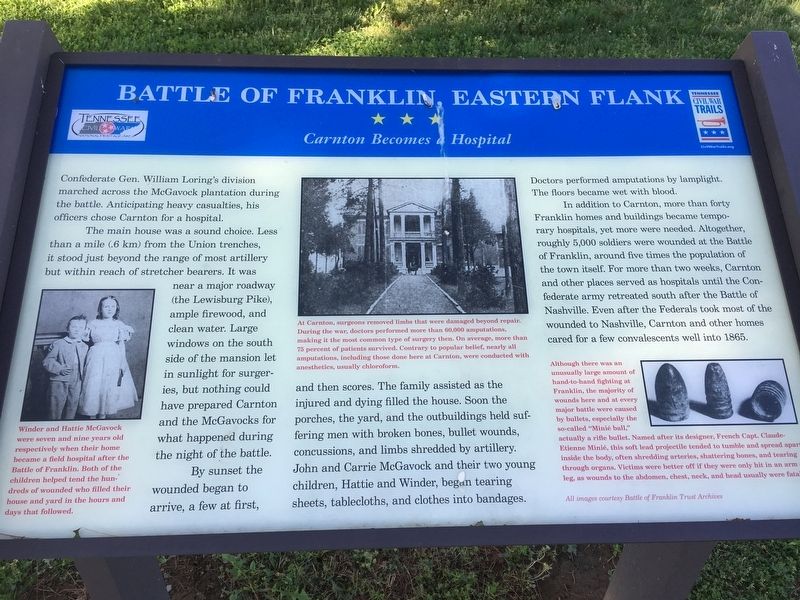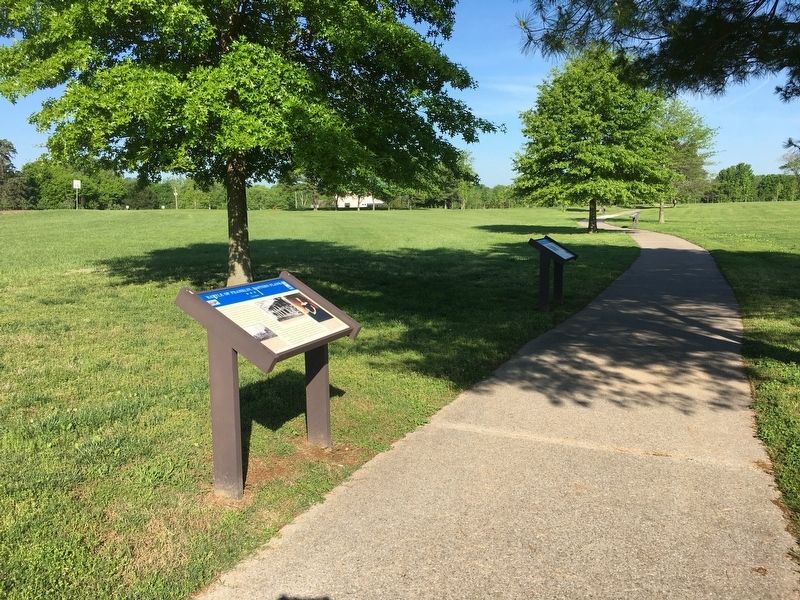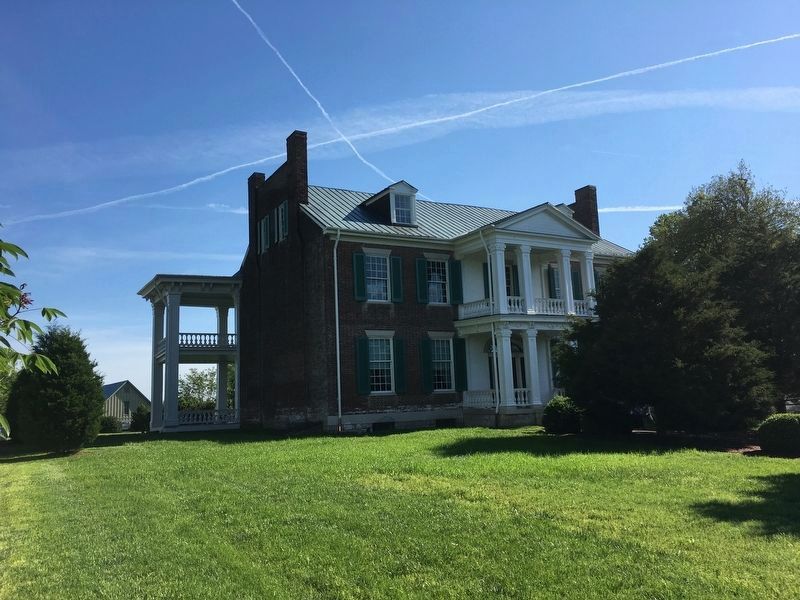Franklin in Williamson County, Tennessee — The American South (East South Central)
Battle of Franklin, Eastern Flank
Carnton Becomes a Hospital
The main house was a sound choice. Less than a mile (.6 km) from the Union trenches, it stood just beyond the range of most artillery but within reach of stretcher bearers. It was near a major roadway (the Lewisburg Pike), ample firewood, and clean water. Large windows on the south side of the mansion let in sunlight for surgeries, but nothing could have prepared Carnton and the McGavocks for what happened during the night of the battle.
By sunset the wounded began to arrive, a few at first, and then scores. The family assisted as the injured and dying filled the house. Soon the porches, the yard, and the outbuildings held suffering men with broken bones, bullet wounds, concussions, and limbs shredded by artillery. John and Carrie McGavock and their two young children, Hattie and Winder, began tearing sheets, tablecloths, and clothes into bandages. Doctors performed amputations by lamplight. The floors became wet with blood.
In addition to Carnton, more than forty Franklin homes and buildings became temporary hospitals, yet more were needed. Altogether, roughly 5,000 soldiers were wounded at the Battle of Franklin, around five times the population of the town itself. For more than two weeks, Carnton and other places served as hospitals until the Confederate army retreated south after the Battle of Nashville. Even after the Federals took most of the wounded to Nashville, Carnton and other homes cared for a few convalescents well into 1865.
Erected by Tennessee Civil War Trails.
Topics and series. This historical marker is listed in these topic lists: Science & Medicine • War, US Civil. In addition, it is included in the Tennessee Civil War Trails series list. A significant historical date for this entry is November 30, 1864.
Location. 35° 54.304′ N, 86° 51.535′ W. Marker is in Franklin, Tennessee, in Williamson County. Marker can be reached from Eastern Flank Circle, 0.4 miles south of Lewisburg Pike (Business U.S. 431), on the right when traveling west. Located in Eastern Flank Battlefield Park. Touch for map. Marker is at or near this postal address: 1345 Eastern Flank Cir, Franklin TN 37064, United States of America. Touch for directions.
Other nearby markers. At least 8 other markers are within walking distance of this marker. A different marker also named Battle of Franklin, Eastern Flank (a few steps from this marker); The Final Campaign 1864 (within shouting distance of this marker); a different marker also named The Battle of Franklin (within shouting distance of this marker); Hood's Retreat (within shouting distance of this marker); Becoming the Front Line 1862 (within shouting distance of this marker); A Crucial War Zone 1863 (within shouting distance of this marker); Standing at the Crossroads 1861 (within shouting distance of this marker); a different marker also named Battle of Franklin, Eastern Flank (within shouting distance of this marker). Touch for a list and map of all markers in Franklin.
Also see . . .
1. Carnton Plantation. (Submitted on May 15, 2017, by Brandon Stahl of Fairfax, Virginia.)
2. National Museum of Civil War Medicine. (Submitted on May 15, 2017, by Brandon Stahl of Fairfax, Virginia.)
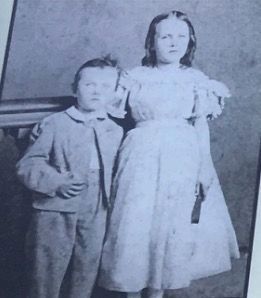
Battle of Franklin Trust Archives
3. Winder and Hattie McGavock
Winder and Hattie McGavock were seven and nine years old respectively when their home became a field hospital after the Battle of Franklin. Both of the children helped tend the hundreds of wounded who filled their house and yard in the hours and days that followed.
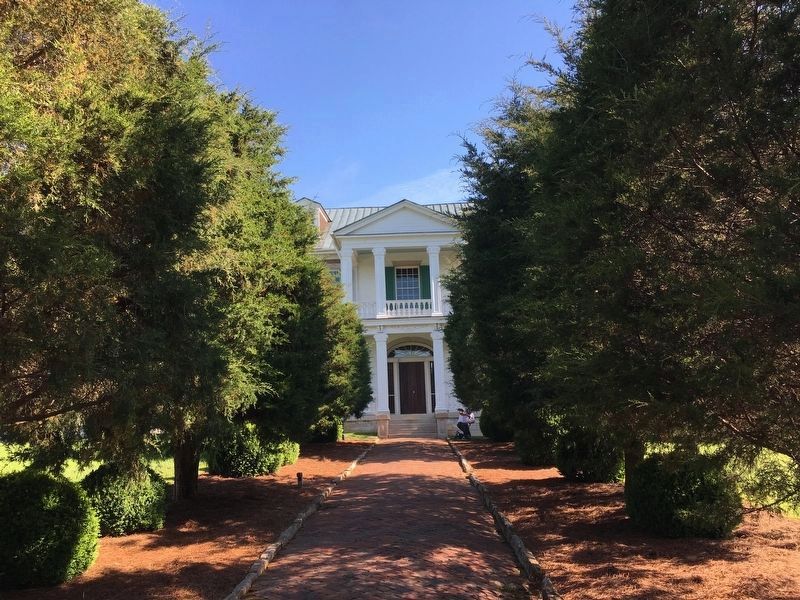
Photographed By Brandon Stahl
4. Carnton
At Carnton surgeons removed limbs that were damaged beyond repair. During the war doctors performed more than 60,000 amputations making it the most common type of surgery then. On average, more than 75 percent of patients survived. Contrary to popular belief, nearly all amputations, including those done here at Carnton, were conducted with anesthetics, usually chloroform.
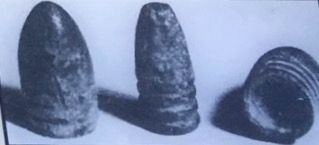
Battle of Franklin Trust Archives
5. Minie Balls
Although there was an unusually large amount of hand-to-hand fighting at Franklin, the majority of wounds here and at every major battle were caused by bullets, especially the so-called “minie ball,” actually a rifle bullet. Named after its designer, French Capt. Claude-Etienne Minie, this soft lead projectile tended to tumble and spread apart inside the body, often shredding arteries, shattering bones, and tearing through organs. Victims were better off if they were only hit in and arm or leg, as wounds to the abdomen, chest, neck , and head usually were fatal.
Credits. This page was last revised on May 16, 2017. It was originally submitted on May 15, 2017, by Brandon Stahl of Fairfax, Virginia. This page has been viewed 321 times since then and 37 times this year. Photos: 1, 2, 3, 4, 5, 6. submitted on May 15, 2017, by Brandon Stahl of Fairfax, Virginia. • Bernard Fisher was the editor who published this page.
